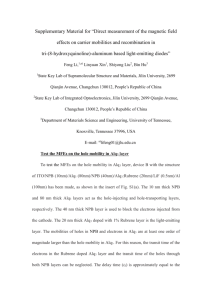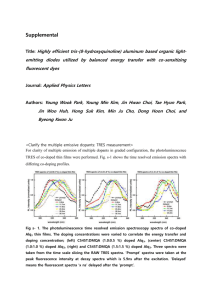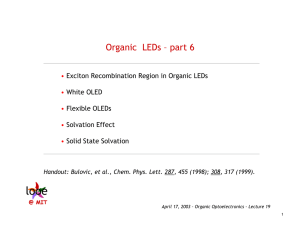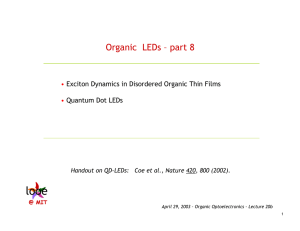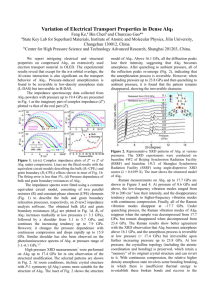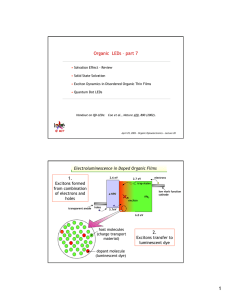Improvement of composition doped with Alq 3 in PR performance
advertisement
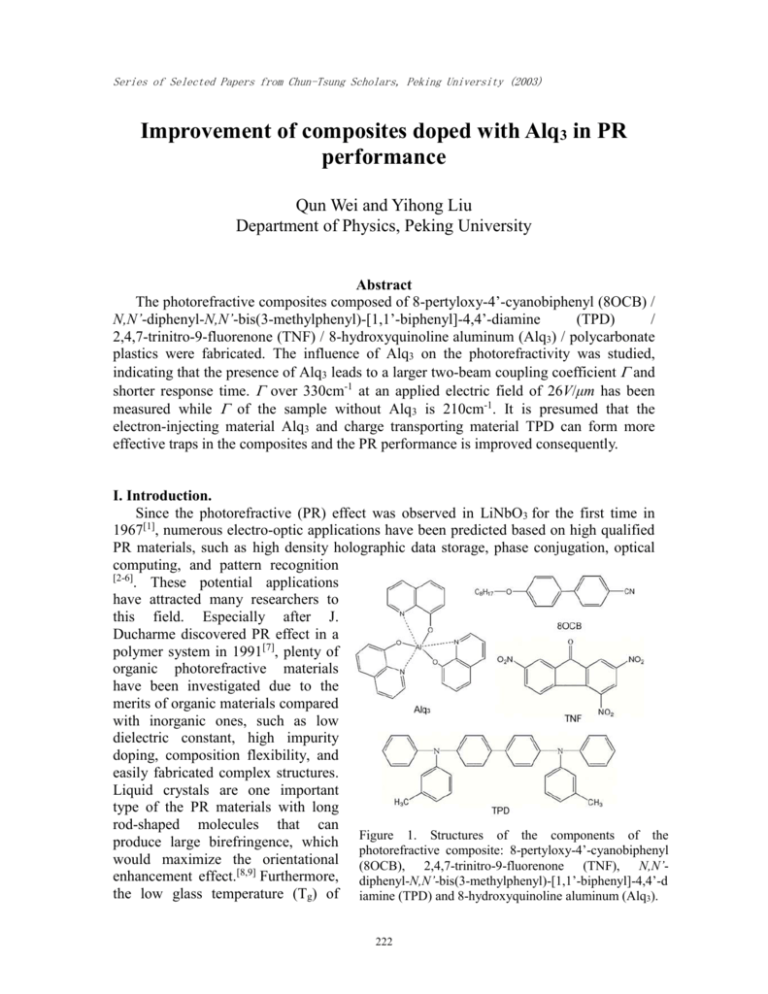
Series of Selected Papers from Chun-Tsung Scholars, Peking University (2003) Improvement of composites doped with Alq3 in PR performance Qun Wei and Yihong Liu Department of Physics, Peking University Abstract The photorefractive composites composed of 8-pertyloxy-4’-cyanobiphenyl (8OCB) / N,N’-diphenyl-N,N’-bis(3-methylphenyl)-[1,1’-biphenyl]-4,4’-diamine (TPD) / 2,4,7-trinitro-9-fluorenone (TNF) / 8-hydroxyquinoline aluminum (Alq3) / polycarbonate plastics were fabricated. The influence of Alq3 on the photorefractivity was studied, indicating that the presence of Alq3 leads to a larger two-beam coupling coefficient and shorter response time. over 330cm-1 at an applied electric field of 26V/μm has been measured while of the sample without Alq3 is 210cm-1. It is presumed that the electron-injecting material Alq3 and charge transporting material TPD can form more effective traps in the composites and the PR performance is improved consequently. I. Introduction. Since the photorefractive (PR) effect was observed in LiNbO3 for the first time in 1967[1], numerous electro-optic applications have been predicted based on high qualified PR materials, such as high density holographic data storage, phase conjugation, optical computing, and pattern recognition [2-6] . These potential applications have attracted many researchers to this field. Especially after J. Ducharme discovered PR effect in a polymer system in 1991[7], plenty of organic photorefractive materials have been investigated due to the merits of organic materials compared with inorganic ones, such as low dielectric constant, high impurity doping, composition flexibility, and easily fabricated complex structures. Liquid crystals are one important type of the PR materials with long rod-shaped molecules that can produce large birefringence, which Figure 1. Structures of the components of the photorefractive composite: 8-pertyloxy-4’-cyanobiphenyl would maximize the orientational (8OCB), 2,4,7-trinitro-9-fluorenone (TNF), N,N’enhancement effect.[8,9] Furthermore, diphenyl-N,N’-bis(3-methylphenyl)-[1,1’-biphenyl]-4,4’-d the low glass temperature (Tg) of iamine (TPD) and 8-hydroxyquinoline aluminum (Alq3). 222 Series of Selected Papers from Chun-Tsung Scholars, Peking University (2003) some liquid crystal results in easy orientation at low external electric field at the room temperature. Some kinds of composites with n-pertyloxy-4’-cyanobiphenyl (nOCB) as the chromophore have been studied and showed excellent PR performance[10,11]. In this study, an electron-injecting material of Alq3[12,13] was introduced to liquid crystal composites based on hole transporting system. It is assumed that Alq3 may serve as traps for electrons in the hole transporting materials and improve the PR performance. So Alq3 was doped into the sample. A much higher two-beam-coupling coefficient and shorter response time were obtained. II. Experiments and results. Figure 1 shows the structures of the compounds used in this study. The composites were added to the matrix of polycarbonate plastics and the proportions are shown in Table 1. To prepare the samples, all the compounds were dissolved in chloroform and mixed sufficiently and equably. Then the solution was dipped onto two glass plates coated with indium tin oxide (ITO) at the temperature of 100°C and sandwiched after chloroform had been evaporated. And the samples were cooled rapidly in order to keep the plastic transparent and get good optical qualities. The thickness of the film was controlled to be 80m by spacers. Table 1. The compositions of two sample. Sample 1 2 8OCB 40 40 TPD 20 20 Composition (wt.%) Plastic 39 37 TNF 1 1 Alq3 0 2 To evaluate the photorefractive effect of the two samples, we carried out the typical two-beam-coupling (TBC) experiment employing a typical tilted geometry shown in Figure 2. The tilt angle is φext=35° in air and two mutually coherent p-polarized He–Ne laser beams at wavelength of 633nm and powers of 10 and 17mW intersected in the sample at angel 2θext=20° in air. The external electric field was pre-applied on the sample for 10 minutes before the measurements. Strong photorefractive effect was observed in both Sample 1 and Sample 2 at electric field Figure 2. Experimental geometry for the TBC experiments. from 6 to 26V/μm. Figure 3 shows the applied electric field dependence of TBC coefficient and inset shows the typical TBC curves of sample 2. The TBC coefficients are calculated by[14]: I 2 I12 cos ln( ), (1) d I1 I 2 I1 I12 I12 where d is the thickness of the film, θ is the tilting angle within the sample, I1 and I2 are the transmitted intensities without coupling, I12 and I21 are the transmitted intensities with coupling, and the index of refraction of the samples is assumed to be 1.6. As what is shown in Figure 3, the TBC coefficient of Sample 2 was much larger than that of sample 223 i n t e n s i t y ( a . u . ) Series of Selected Papers from Chun-Tsung Scholars, Peking University (2003) 350 B e a m 1 . 6 2 B e a m B e a m o n 1 2 S a m p l e S a m p l e 1 . 4 1 2 1 . 2 B e a m -1 (cm ) 1 . 0 300 0 . 8 0 . 6 0 . 4 250 0 . 2 0 . 0 200 0 2 4 6 8 10 12 14 T i m e ( s ) 150 100 50 0 0 5 0 0 1 0 0 0 1 5 0 0 2 0 0 0 2 5 0 0 V o l ta g e (V ) Figure 3. The dependence of TBC coefficient on applied electric field, inset is the typical TBC curve. 160 150 Sample 1 Sample 2 140 130 TBC Buildup Time (s) 120 110 100 90 80 70 60 50 40 30 20 10 0 -10 600 800 1000 1200 1400 1600 1800 2000 2200 Voltage (V) Figure 4. The dependence of response time on applied electric field. 224 Series of Selected Papers from Chun-Tsung Scholars, Peking University (2003) 1 at higher applied electric field. was measured to be as high as 336cm-1 and 213cm-1 at 26 V/μm for two samples, respectively. And the response time of PR grating-buildup is depicted in Figure 4. The response time of sample 2 is much shorter than that of sample 1. Energy level (eV) III. Discussion. The improvement of sample 2 in TBC coefficient and response time possibly results from the increase of trap density caused by presence of Alq3. Figure 5 shows the energy levels of the compounds of samples. The LUMO (Lowest Unoccupied Molecular Orbital) level of Alq3 is lower than that of TPD, and Alq3 is a good electron-injecting material. Therefore, the photo-generated electrons are easier to inject to Alq3’s LUMO level. Alq3 has a little content in composites and is surrounded by TPD molecules. 0 0 Thus, the electrons can hardly Alq TPD ITO TNF continue transporting in Alq3. In -1 -1 3 other words, the electrons were -2 -2 LUMO trapped by quantum dots which are -3 -3 formed by the difference of LUMO -4 -4 level between Alq3 and TPD. And the HOMO (Highest Occupied -5 -5 HOMO Molecular Orbital) level of Alq3 is a -6 -6 little lower than that of TPD, so Alq3 -7 -7 has no big influence on the -8 -8 hole-transportation. Therefore, the separation of charge carriers Figure 5. The energy levels of TNF, TPD, Alq3 becomes easier and quicker. And a and ITO[15,16]. stronger internal space-charge field is formed in shorter time which results in improvement of PR performance[17-19]. In order to confirm this point, some more experiments have been made and two of them are worth mentioning here. Current-voltage characteristics were measured in the dark and at 633nm He-Ne laser’s illumination, respectively. The photocurrent was given by subtracting dark current from light current (jphoto=jlight-jdark)[20]. In sample 1, jphoto=jephoto+jhphoto (where jephoto is the photoelectron current, jhphoto photohole current and electron-hole combination current is neglected). According to the analysis above, the quantum dots which are able to trap the photo-generated electrons will lead to a decrease in the number of free carriers in sample 2, so the photocurrent should be smaller than that across sample 1. Meanwhile, the dark currents of two samples should have no big difference since there are no photo-generated electrons and the current is caused by the hole-injection from ITO to HOMO level of TPD. The result is shown in Figure 6. Considering the error in the measurement, the dark currents of two samples have no evident difference while it is obviously that the photocurrent of sample 1 is much larger than that of sample 2. This result is completely consistent with the theoretical analysis. The decay time of photocurrent was measured. The experimental set-up is shown in Figure 7. An optic parameter amplifier ns-laser pulse with width of 10 nm was illuminated on the sample in the direction of the sample normal while the external electric 225 Series of Selected Papers from Chun-Tsung Scholars, Peking University (2003) field was applied. The dependence of current on time was recorded by an oscillograph. Because of the different mobility of electrons and holes, there should be a long tail in the current-time curve. In accordance with the theory above, some photo-generated electrons are trapped by the quantum dots and the current decay of sample 2 is chiefly determined by the mobility of holes. Hole mobility is larger than electron mobility in TPD[21]. Therefore, the tail of Sample 2 should be shorter than that of Sample 1. The prediction agrees with the experimental results, which are shown in Figure 8. dark current of sample 2 dark current of sample 1 photocurrent of sample 2 photocurrent of sample 1 250 Current(A) 200 150 100 50 0 0 500 1000 1500 2000 2500 Voltage(V) Figure 6. The dependence of dark current and photocurrent on applied electric field. Figure 7. The set-up measuring the samples’ response to the ns-laser pulse. 226 Series of Selected Papers from Chun-Tsung Scholars, Peking University (2003) 14 Sample 1 Sample 2 Laser pulse signal Current (a.u.) 12 10 8 6 4 2 0 500 1000 1500 2000 2500 T(nm) Figure 8.The dependence of current on time decay. The two experiments above authenticate the view that the remarkable improvements both in TBC coefficient and response time in sample 2 mainly come from the effect Alq3 having on the increase of density of trapping sites. V. Conclusion. Electron-injecting material of Alq3 has been introduced to hole-transporting based PR composites to improve PR performance. The TBC coefficients and response time of the samples with and without Alq3 were measured and compared. It is obviously that the presence of Alq3 leads to remarkable improvements in sample’s photorefractive characteristics. And the explanation has been made and validated by experiments. In addition, in the process of measurement, the samples could last for more than two months, which indicates that the samples have great stabilities. We also found that the transparence of the sample has noticeable influence on the PR performance. The further work about the composites is still carrying on. Acknowledgement. We acknowledge Hui-Chun Chin and Tsung-Dao Lee Chinese Undergraduate Research Endowment (CURE), the National Science Foundation of China under grant Nos. 10104003, 90206003 and 90101027, and the National Key Basic Research Special Foundation (NKBRSF) under grant No TG1999075207 for the support of the work. And we are very grateful to the guidance of our instructors Associate Prof. Chen Zhijian and Prof. Gong Qihuang in out research. We also appreciate the help of Huang Maomao, 227 Series of Selected Papers from Chun-Tsung Scholars, Peking University (2003) Zhang Jie and Li Fushan in the experiment. And we thank Associate Prof. Xun Kun for providing the equipment for fabrication of OLED films. References: [1]. F. S. Chen, J. Appl. Phys. 38, 3418 (1967) [2]. B. L. Volodin, B. Kippelen, K. Meerholz, B. Javidi, N. Peyghambarian, Nature 383, 58 (1996) [3]. Rahn MD, West DP, Khand K, Shakos JD, Shelby RM, Appl. Opt. 40, 3395 (2001) [4]. S.J. Zilker, Chem. Phys. Chem. 1 72 (2000) [5]. F. Wünthner, R. Wortmann, K. Meerholz, Chem. Phys.Chem. 3 17 (2002) [6]. C. Gu et al. Optical Materials 23, 219–227 (2003) [7]. S. Ducharme, J. C. Scott, R. J. Twieg, and W. E. Moerner, Phys. Rev. Lett. 66, 1846 (1991) [8]. Jaehoon Hwang, Jangwon Seo, Jiwon Sohn, Soo Young Park, Optical Materias. 21 359(2002) [9]. Moerner WE, Silence SM, Hache F, Bjorklund GC, J. Opt. Soc. Am. B.11, 320(1994) [10]. LIU Hui, ZHANG Bo, Gong Qi-Huang, Bai Yao-Wen, Chin.Phys.Lett. 18, 7, 909 (2001) [11]. Y. Bai, Q.F. Zhou, H. Liu, B. Zhang, Q.Gong, Appl. Phys. B 73, 35–37 (2001) [12]. Tang C.W., VanSlyke S.A. and Chen C.H., J. Appl. Phys. 65 3610–16 (1989) [13]. Kalinowski J., Camaioni N., Di Marco P., Fattori V. and Giro G., Int. J. Electron. 81 377–400 (1996) [14]. K.Meerholz, B.L.Volodin, Sandalphon, K. Kippelen, and N. Peyghambarian, Nature (London) 371, 497 (1994) [15]. Seth C., Wing-Keung W., Moungi B. and Vladimir B., Nature 420 800-803 (2002) [16]. D.P. West et al., Chem. Phys. Lett. 326 407-412 (2000) [17]. W. E. Moerner and S. M. Silence, Chem. Rev. 94, 127 (1994) [18]. G. G Malliaras, V. V Krasnikov, H. J. Bolink,and G. Hadziioannou, Appl. Phys. Lett. 66, 1038 (1994) [19]. Reinhard Bittner and Klaus Meerholz, Gregory Steckman and Demetri Psaltis, Appl. Phys. Lett. 81,211(2002) [20]. P. Klysubun and G. Indebetouw, J. Appl. Phys.92, 5 , 2528 (2002) [21]. L.S.Hung, C.H.Chen, Materials Science and Engineering R 39 143-222 (2002) 作者简介: 刘轶鸿,女,1982 年 8 月出生于天津市,2000 年从天津南开中学毕业,获第十 六届全国中学生物理竞赛三等奖保送进入北京大学物理学院物理专业学习。2000 学 年获得新生奖学金,2001 年获得 IET 奖学金。 魏群,男,1982 年 6 月出生于山西省长治市,2000 年从长治第二中学毕业,获 第十六届全国中学生物理竞赛三等奖保送进入北京大学物理学院物理专业学习。 2000 学年获得新生奖学金。 在校期间,两人刻苦勤奋,积极参与课内外各种活动。2002 年两人受“ 政基 金”资助,进入物理学院人工微结构与介观物理国家重点实验室,在龚旗煌和陈志 坚两位老师的指导下,进行有机光电材料的研究。 感悟与寄语: 进入大学后,对于学以致用的欲望愈加强烈,而“ 政基金”无疑是一个非常 228 Series of Selected Papers from Chun-Tsung Scholars, Peking University (2003) 好的机会。我们研究的课题是有机光电材料,正是一个理论与实用相结合的课题。 科研同日常的上课是很不同的,很多问题在理论上没有直接对应,大胆合理的猜想 和尝试是必要的。通过一年多的科研工作,我们受到了很有效的锻炼,在思维方式 和动手能力方面都有了很大的提高,而且对于整个科研活动的流程有了切身的体验, 两位老师的耐心指导也给了我们莫大的帮助。参与“ 政基金”对于我们未来的学 习和工作都是一次宝贵的经历。 指导老师简介: 龚旗煌:男,长江特聘教授,博士生导师。 北京大学人工微结构和介观物理国 家重点实验室主任、北京大学现代光学研究所所长、中科院--北京大学联合超快光 科学和激光物理中心常务副主任。1964年8月出生于福建。主要研究方向为:飞秒超 快超强光物理、新型有机非线性光学材料和光子学材料及器件研究。 陈志坚:男,副教授,1971年11月出生于山东。主要在新型有机电致发光和非 线性光学材料方面开展研究工作。 229
